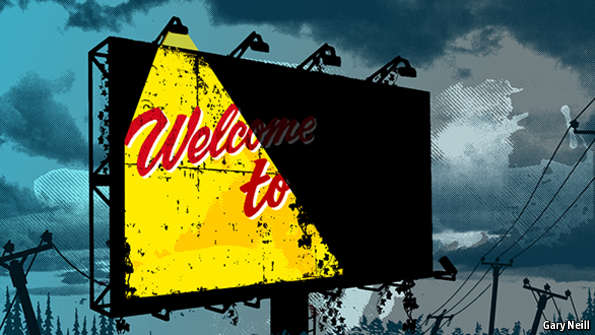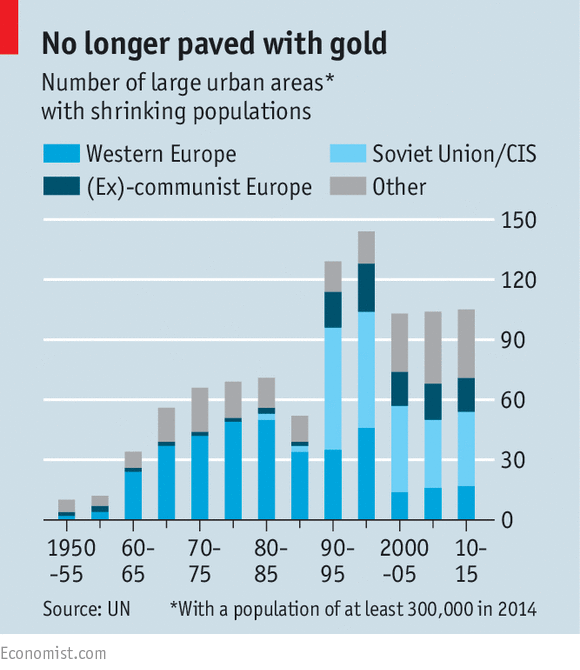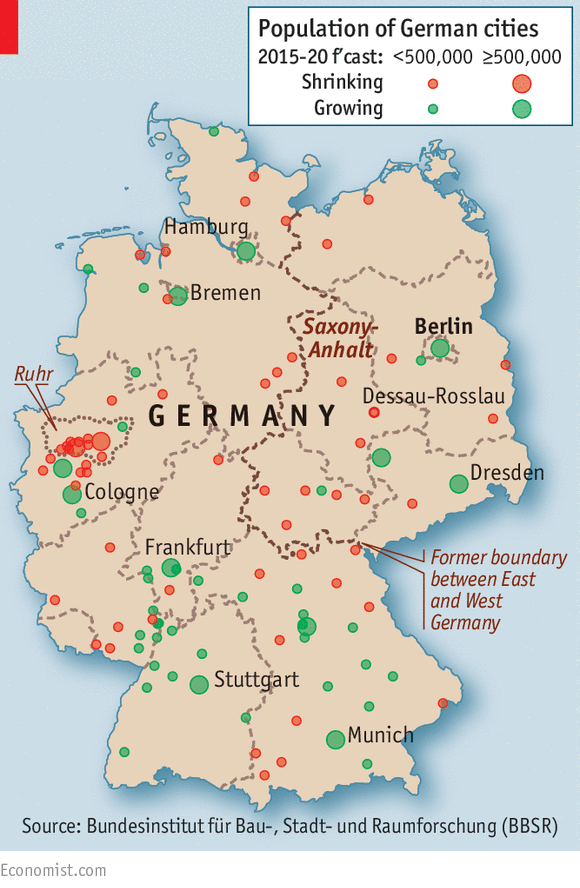Franchising, retail, business

30/05/2015
A growing number of cities will have to plan for drastically smaller populations
IN LEIPZIGER TOR, people are giving way to grass, flowers and potatoes. So many prefabricated 1950s apartment buildings have been razed in this working-class district of Dessau-Rosslau, a city in eastern Germany, that the plants receive all the light and rain they need. And the local planners have other buildings in their sights. Some residential blocks are half-empty. An abandoned school is succumbing to weeds. They too will probably be demolished and replaced by meadows.
Many of the world’s cities are having to cope with rapid growth. Dessau-Rosslau’s challenge is to manage decline. Since 2007 its population has dropped by almost 10,000, to 81,500. Everybody, from the city authorities to the man in the street, reckons the trend will continue. What will Dessau-Rosslau be like in ten or 20 years’ time? “Smaller,” says Rolf Müller, a longtime resident, as he carries a box of groceries out of an Aldi supermarket.
The condition from which Dessau-Rosslau suffers is increasingly common. From 1950 to 1955 only ten of the world’s largest conurbations lost people, according to the UN (see chart). The tally rose steadily over the next few decades, before jumping in the 1990s, as the collapse of communism in eastern Europe and Russia was followed by a colossal migration. Today just over 100 conurbations are losing people. But this greatly understates the scale of urban decline. In many countries, big cities with diversified economies are growing at the expense of cities too small to make the UN’s list. Germany has 107 autonomous cities, of which 60 are expected to contract over the next five years. But almost all of the biggest cities will escape decline (see map).
Shrinking cities can be found in the post-industrial rustbelts of the American Midwest, eastern Europe and northern England. But the phenomenon is increasingly Asian. In Japan 20 cities with more than 300,000 inhabitants each declined in population between 2005 and 2010. The two largest cities in South Korea, Busan and Seoul, are both contracting. Even rapidly urbanising countries like China and India have a few declining cities. In 2008 the UN estimated that one in ten emerging-world cities were losing people. The only part of the world where shrinking cities are almost unknown is sub-Saharan Africa. But that too will change.
A city can lose some people and barely notice. It might even have to build more homes, since in many countries more people are living alone. But persistent decline is harmful, especially if the population is ageing as well as shrinking. As factories and homes are abandoned, the local economy can spiral downward.
Detroit, which has lost more than half its population since 1950, provides a terrible warning. The city filed for bankruptcy in 2013, having failed to raise enough taxes from its diminished workforce to pay its debts and support an army of retired teachers and cops. It has become a husk, plagued by violence and hopeless schools. Its once-vibrant shopping streets have been reduced to selling what George Galster, an urbanist at Wayne State University, calls “lotto, liquor and the Lord”.
Cities lose people because of two processes, which often happen at the same time. The first is migration—whether from a city in one country to a city in another, from city to city within a country, or from city to suburb. The cause is often industrial decline. Khulna, a city of more than 1m in Bangladesh, has contracted along with its jute industry. Middlesbrough, in England, has not recovered from the loss of shipbuilding. In many cases, workers do not move far. Detroit is surrounded by successful suburban cities; the overall population of the metropolis has changed little over the past few decades. Seoul has probably lost people to the burgeoning aerotropolis of Incheon, 30 miles (48km) away.
The second cause is demographic change. Though increased life expectancy can delay the moment of reckoning, once a country is largely urbanised, its cities will contract unless it can attract enough immigrants or deliver enough babies to counterbalance the number of deaths. Japan and Russia are already failing to do this, and South Korea is approaching the edge. Japanese women have 1.4 children each, on average; though South Korea’s population is younger, its women have just 1.2. Neither country wants mass immigration. Successful cities in such countries will be able to grow by poaching inhabitants from unsuccessful ones. But as the total population falls it will become clear that they are playing a national game of demographic musical chairs, competing for an ever-shrinking number of people. China will soon be doing this, too: the UN reckons its urban population will be declining by 2050.
Ground zero for decline
It is the peculiar misfortune of Dessau-Rosslau to have suffered from swift emigration and steep demographic decline at the same time. After being almost flattened by British bombers in the second world war, Dessau ended up in the German Democratic Republic. It was designated an industrial centre, making chemicals and railway wagons for the communist world. German reunification in 1990 exposed its inefficient factories to crushing competition. As unemployment soared, ambitious young people fled to western Germany. Fatally for fertility, women were especially likely to move. Dessau-Rosslau now has 31,000 inhabitants aged at least 60 but only 11,000 under the age of 20.
The city at first tried to revive itself by building new homes and offices on a disused Soviet airfield, as well as shopping centres. That is a common response to urban decline, in Germany and elsewhere, and is often encouraged by government tax breaks. But it did not work. As the population continued to plunge, buildings fell out of use. Some were demolished, in piecemeal fashion. The city plainly had two options, neither of which involved growth. It could decline erratically, becoming “like a cheese with a lot of holes”, in the words of Heike Brückner, a planner at the Bauhaus Foundation in Dessau-Rosslau. Or it could do something more drastic.
In 2002 the city began to plan for its own destruction. Ms Brückner and others drew a large S-shape through the southern part of the city, an area of closed factories and apartment buildings without lifts. Demolitions would be concentrated there, while the city worked to shore up its more successful neighbourhoods. Buildings would give way to a broad “landscape zone”, with grassy meadows cut once or twice a year. Small plots, 20 metres by 20 metres, would be given to all those who had plans to use them.
As is often the way with bold urban schemes, this one did not quite go to plan. Many people were reluctant to leave their basic but cheap communist-era flats. As some apartment buildings were demolished, nearby ones became more desirable, partly because supply and demand were more balanced and partly because the remaining buildings were surrounded by open space. Some enterprising owners spruced up their buildings and marketed them aggressively to displaced tenants. Although many blocks have come down, enough remain standing that it takes some imagination to detect a landscape corridor slicing proudly through the city.
Even so, demolition has worked. Leipziger Tor, the neighbourhood where most buildings have come down, is poor and declining but strikingly short of dereliction. On a fine early summer morning, several people are in the meadows picking wild flowers, amid the odd placard showing where buildings once stood. Inspired by this example, nearby cities are also knocking buildings down. Some are in effect travelling back in time, getting rid of post-war apartments on their fringes while prettifying their medieval cores.
Demolition crews have also been at work in some of the most severely depleted Japanese towns and in the American Midwest, where the process is gently known as “right-sizing”. Pittsburgh, once a declining industrial city, has enthusiastically bulldozed houses and factories, particularly along its waterfront, and replaced them with parks. It has even started to grow again, though that is probably mostly thanks to its thriving universities.
Yet east Germany stands out as exceptionally bold. The extraordinary steepness of its population decline seems to have concentrated minds. It is also unusual in having low rates of home ownership: the average in Saxony-Anhalt, the state that contains Dessau-Rosslau, is under 40%. And, as Michael Voigtländer of the Cologne Institute for Economic Research points out, the rental market in post-communist cities is often highly concentrated—in Dessau-Rosslau three companies own most of the stock. Where there are hundreds or even thousands of landlords, co-ordination is far harder.
A commoner response to population decline is to try to reverse it, if necessary by luring inhabitants from growing cities to shrinking ones. The Japanese government is aiming to create 300,000 jobs outside the big cities, partly by persuading businesses to leave Tokyo. It also has a target for cutting the number of young people who move to the capital every year: big-city living is believed to encourage childlessness. Much of this is wrong-headed, argues Tatsuo Hatta, an economist. Tokyo draws young people because of its growing, services-oriented economy, and they leave when they want children. He thinks Japan should move to a nationalised system for financing old-age care, as in America. That would lead to small cities and towns competing for aged residents.
Across the world, many cities are likely to lose inhabitants faster than buildings. To plan for shrinkage is to admit that people will not come back, which sounds like an admission of failure. But it may be a greater failure to seek fruitlessly to hold on to the past. Cities rise and fall, sometimes several times, changing shape as they go. It is part of their magic.
Fonte:http://www.economist.com/news/international/21652314-growing-number-cities-will-have-plan-drastically-smaller-populations-rus?fsrc=scn/tw/te/pe/ed/rusinurberedux